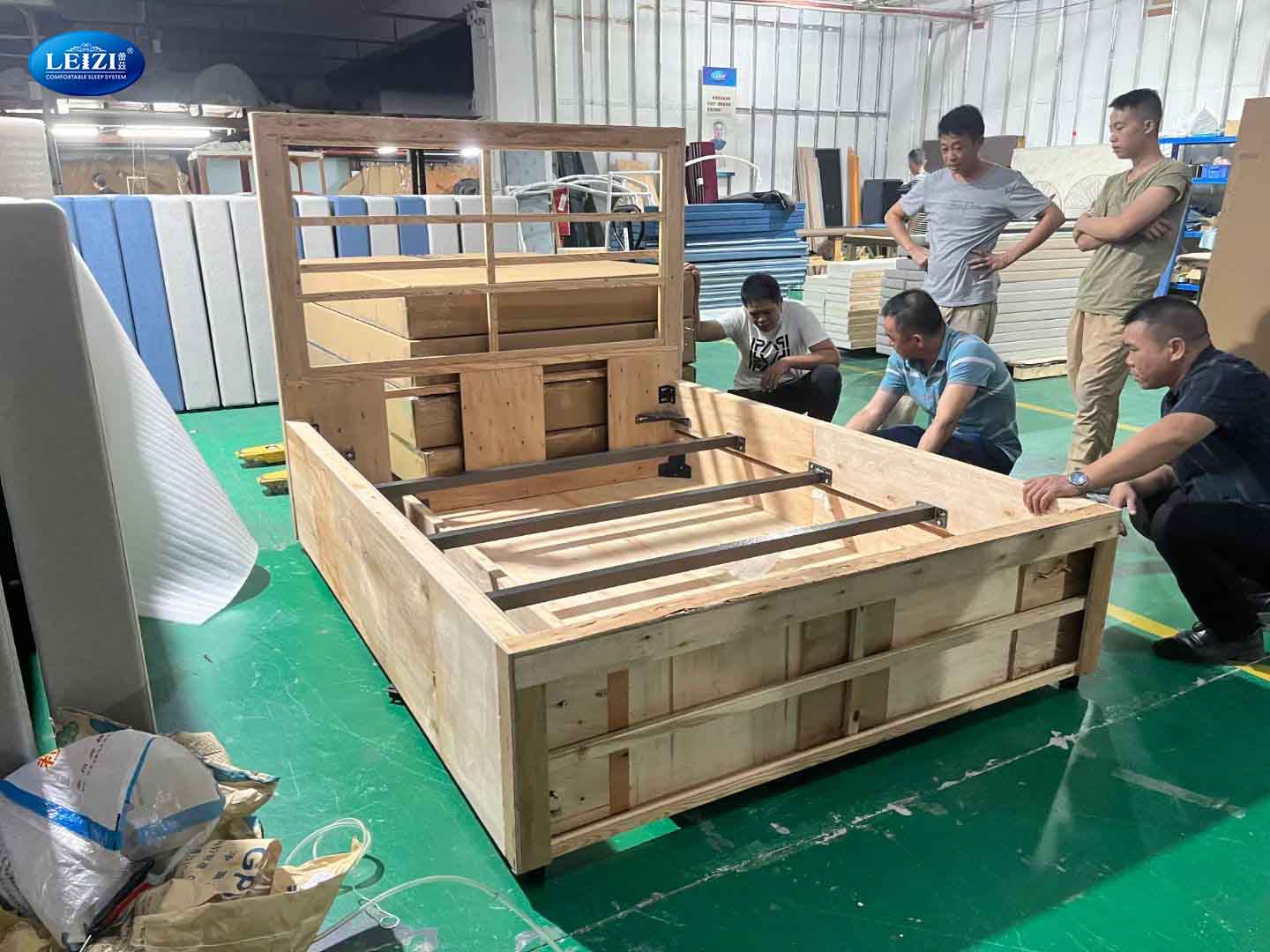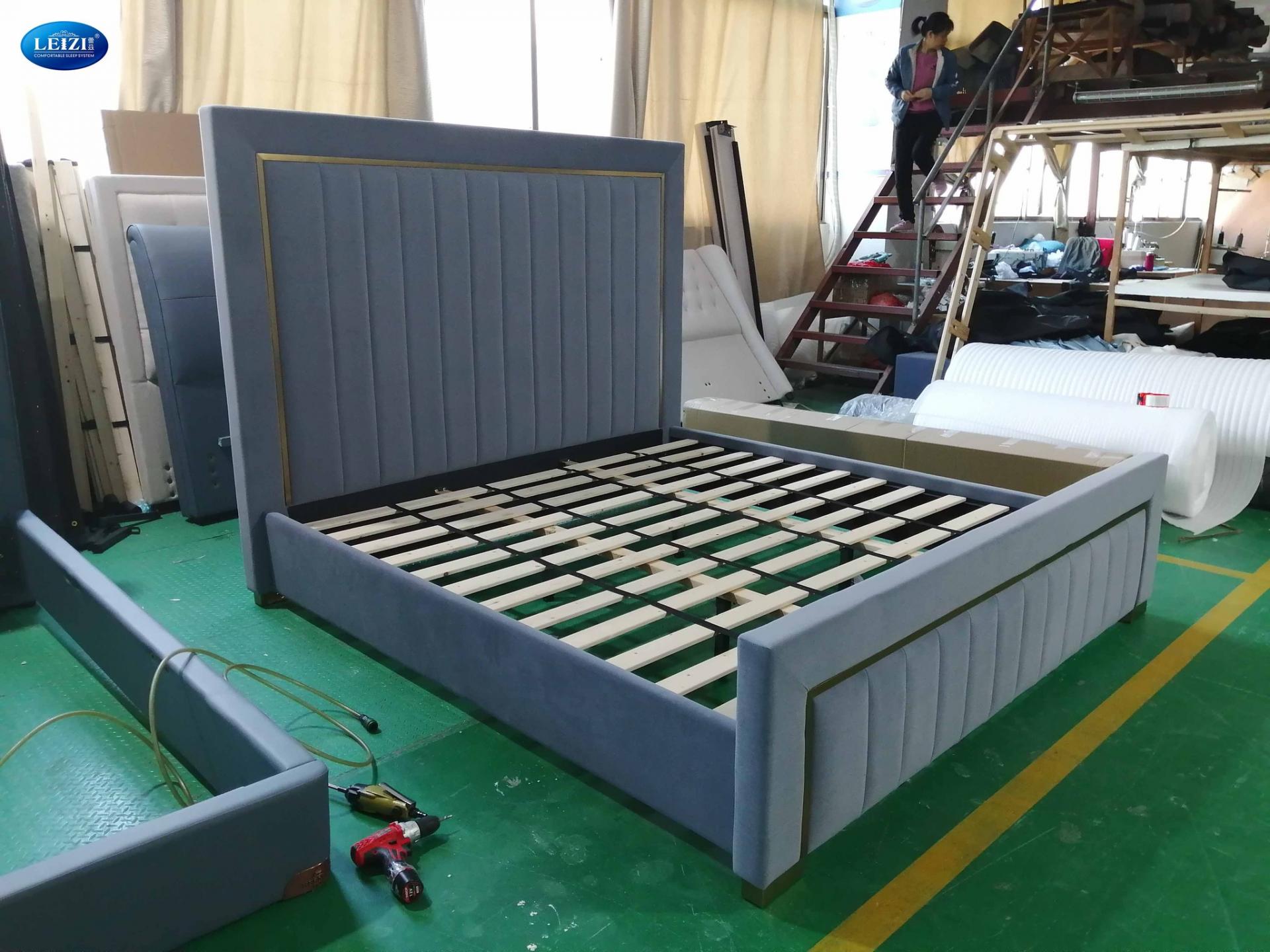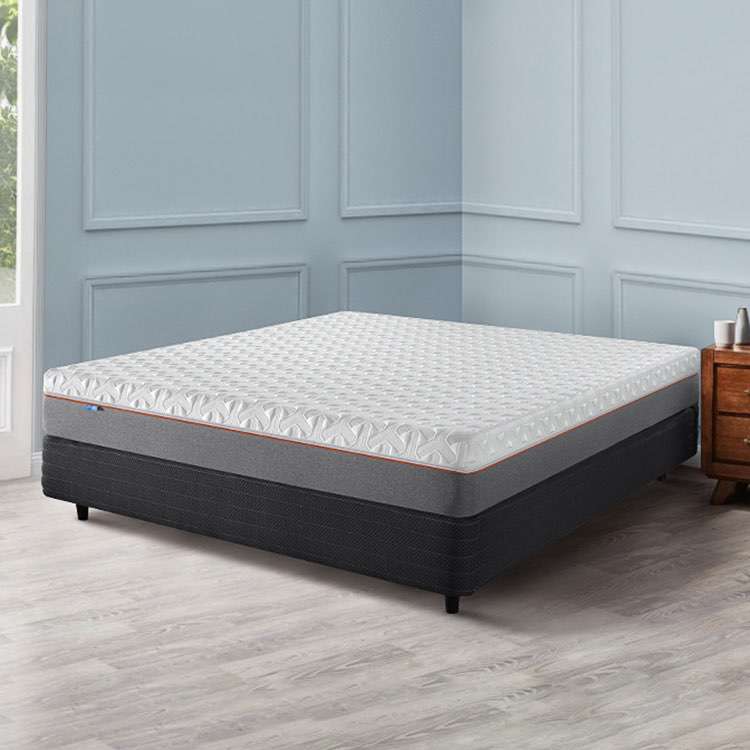How to Reinforce a Bed Frame for Ultimate Stability
 FOSHAN LEIZI FURNITURE CO., LTD
FOSHAN LEIZI FURNITURE CO., LTD  April 29,2024
April 29,2024
A good night's sleep is invaluable. It rejuvenates us, restores our energy, and prepares us for the challenges of the day ahead. Yet, for many, an annoying and persistent problem disrupts this essential nightly ritual – a creaky and unstable bed frame. If you're tired of your bed frame groaning with every movement, it's time to reinforce bed frame.
Picture this: you settle into your custom bed frame, the soft mattress inviting you to relax, but as you shift your weight, the frame protests with a series of unwelcome squeaks. This guide will equip you with the knowledge and tools needed to reinforce bed frame, turning it into a sturdy and dependable support system for your well-deserved slumber.
To reinforce bed frame isn't just about stopping the squeaks; it's about enhancing your overall sleep experience. It's about creating a haven where you can rest peacefully, free from the disturbances caused by an unreliable bed frame.
In this journey, we'll explore the reasons why you should consider to reinforce bed frame, help you assess its current condition, provide step-by-step instructions on making it more robust, uncover the causes of those frustrating bed frame squeaks, and guide you on when it's time to bid farewell to your old frame. By the end of this guide, you'll have the knowledge and confidence to ensure that your bed frame offers you the restful nights you deserve.
Why Reinforce Bed Frame
When we think of achieving a good night's sleep, we often focus on the quality of our mattress, the coziness of our bedding, or even our sleep habits. Yet, we often overlook a fundamental element that plays a pivotal role in our sleep experience - the bed frame. The decision to reinforce bed frame is not just about preventing squeaks; it's about creating a stable foundation for the restorative sleep your body and mind require.
1. Support Matters: Your bed frame is responsible for supporting your mattress, which in turn supports your weight. Over time, wear and tear can cause the frame to lose its original strength and stability, so it is especially important to reinforce bed frame.
2. Peaceful Sleep: A bed frame that creaks and groans with every move can turn a peaceful night's sleep into an aggravating ordeal. They can disrupt your sleep cycle, causing awakenings and leaving you feeling fatigued the next day, so it is especially important to reinforce bed frame.
3. Longevity of Your Mattress: A weakened bed frame can accelerate mattress wear and tear, reducing its lifespan, so it is especially important to reinforce bed frame.
4. Safety First: A shaky or wobbly bed frame poses a safety risk. It can lead to accidents and injuries, especially if you have children or pets who might play or jump on the bed. Reinforcing bed frame ensures it remains a secure and stable piece of furniture.
5. Customization Possibilities: If you've invested in a custom bed frame or plan to, reinforcing it is a smart choice. Custom bed frame are designed to meet your unique needs and style preferences.
In essence, reinforce bed frame is the unsung hero of your bedroom, quietly providing the foundational support you need for restorative sleep. It's a small yet essential step in optimizing your sleep environment, ensuring that you wake up refreshed, rejuvenated, and ready to conquer the day.
Assessing Bed Frame's Condition
Before embark on the journey to reinforce bed frame, it's essential to perform a thorough assessment of its current condition. This step is critical because it will help you identify any weaknesses or issues that may be contributing to discomfort or those annoying creaks and wobbles. Here's how you can evaluate the health of bed frame:
1. Visual Inspection: Start by visually inspecting your bed frame. Look for any obvious signs of damage, such as cracks, dents, or loose screws. Once discovered, remember to reinforce bed frame.
2. Physical Inspection: Give your bed frame a physical test. Apply gentle pressure to various parts of the frame, including the corners and the center. If you notice excessive flexing, shifting, or creaking during this test, it's a sign that need reinforce bed frame.
3. Listen for Noises: Lay down on the bed and move around. Listen for any squeaks, creaks, or groans that occur when you shift your weight. These noises are often indicative of loose or worn-out components. Once discovered, remember to reinforce bed frame.
4. Check for Sagging: Place a straight edge, such as a level or a long, straight board, across the surface of the bed frame. If you notice any significant sagging in the middle or along the sides, it's a clear indication that the frame is not providing adequate support. Once discovered, remember to reinforce bed frame.
5. Evaluate Center Support: If you have a larger bed like a queen or king size, check for proper center support. A center support beam or leg should be in place to distribute the weight evenly and prevent sagging in the middle, and can reinforce bed frame..
6. Examine Screws and Fasteners: Tighten all screws and fasteners. Over time, these can become loose due to normal use. Once discovered, remember to reinforce bed frame.
7. Test Stability: Push the bed frame from different angles to assess its stability. It should not wobble or shift excessively. If it does, it's a clear sign that it requires reinforce bed frame.
8. Check for Rust or Corrosion: If your bed frame is made of metal, inspect it for any signs of rust or corrosion. Rust weakens the structure and can compromise its integrity.
By conducting a thorough evaluation of your bed frame, you'll gain a clear understanding of its condition and any areas that need attention. Identifying issues early on allows you to take proactive measures to reinforce bed frame and ensure it continues to provide the stable and supportive foundation your mattress and, ultimately, your sleep, depend on.
How to Make Your Bed Frame More Robust
Now that you've assessed your bed frame's condition and identified any weaknesses, it's time to take action and reinforce bed frame to ensure a sturdy and dependable sleep surface. To reinforce bed frame not only enhances your sleep quality but also prolongs the life of your mattress and reduces the risk of accidents. Here's a step-by-step guide on how to make your bed frame more robust:
1. Tighten Loose Screws and Fasteners: Start by tightening all screws, bolts, and fasteners on the bed frame. Use appropriate tools and make sure all connections are tight. This reinforce bed frame can often eliminate minor squeaks and shaking.
2. Reinforce Joints: If your bed frame has wooden joints, consider reinforcing them with corner brackets or L-brackets. These reinforce bed frame can provide extra stability to weak or wobbly corners.
3. Add Support Beams: For larger bed frames like queen or king sizes, adding additional support beams can make a significant difference. Measure the distance between the existing support beams and add one or two more, evenly spaced, for better weight distribution, can reinforce bed frame.
4. Invest in a Center Support Leg: If your bed frame lacks proper center support, install a center support leg or beam and reinforce bed frame. This is crucial for preventing sagging in the middle, especially on larger frames.
5. Use Plywood Panels: If your bed frame has wooden slats that are not providing adequate support, consider placing plywood panels on top of them. Reinforce bed frame provides a solid surface for your mattress to rest on and can eliminate sagging.
6. Lubricate Noisy Joints: If squeaky joints are the issue, apply lubricant to the contact points to reinforce bed frame. Be sure to use a lubricant suitable for the material of your bed frame, such as silicone spray for metal frames or wax for wooden ones.
7. Check and Replace Damaged Parts: Inspect your bed frame for any parts that are beyond repair. If you find severely damaged or cracked components, replace them to ensure the frame's structural integrity and reinforce bed frame.
8. Upgrade to a Stronger Frame: If your bed frame is irreparably damaged or if you're looking for a long-term solution, consider upgrading to a stronger and more robust frame. Custom bed frame with reinforced structures are available and can be tailored to your specific needs.
9. Regular Maintenance: To reinforce bed frame, perform periodic checks for loose fasteners or signs of wear. Regular maintenance can prevent issues from reoccurring.
By following these steps, you can transform your bed frame into a stable and reliable foundation for your mattress, ensuring a peaceful night's sleep free from creaks and wobbles. To reinforce bed frame not only enhances your sleep quality but also safeguards your investment in a comfortable mattress and promotes safety in your bedroom.

What Causes a Bed to Squeak?
The maddening sound of a squeaky bed frame can turn what should be a tranquil night's sleep into a frustrating ordeal. Let's delve into the common reasons behind bed frame squeaks and groans:
1. Loose Fasteners: Over time, the screws, bolts, and nuts that reinforce bed frame together can become loose due to regular use. This creates gaps between joints, causing friction and resulting in those annoying squeaks.
2. Worn Joints: The joints of your bed frame, especially in wooden frames, can experience wear and tear. The constant pressure and movement weaken these connections, making them more prone to producing noise, so reinforce bed frame.
3. Insufficient Lubrication: Lack of lubrication at contact points can cause friction between parts, leading to squeaks. Adequate lubrication reduces this friction, preventing noise from occurring, can reinforce bed frame.
4. Inadequate Support: If your bed frame lacks proper support beams, slats, or center legs, it can flex and bend when weight is applied, resulting in noise, so reinforce bed frame.
5. Material Deterioration: Wooden bed frames are susceptible to moisture and temperature changes that can cause the wood to expand or contract. This can lead to friction between parts and create squeaks, so reinforce bed frame.
6. Age and Usage: Simply put, the longer a bed frame is in use, the more likely it is to develop squeaks and creaks. Regular wear and tear, coupled with the weight of the mattress and occupants, contribute to these noises over time, so reinforce bed frame.
7. Uneven Weight Distribution: If the weight on the bed is not evenly distributed, certain areas of the frame can experience more stress and friction than others, resulting in squeaks in those specific spots, so reinforce bed frame.
Now that you know why your bed frame might be squeaking, it's time to take action and address these issues. By tackling these root causes of squeaks, you can reinforce bed frame and enjoy a peaceful night's sleep without the constant annoyance of a noisy bed frame.
When to Replace Your Bed Frame
To Reinforce bed frame can work wonders in extending its lifespan and ensuring a comfortable sleep environment. However, there comes a point when repair and reinforcement may no longer suffice, and it becomes necessary to consider replacing your bed frame.
1. Structural Damage: If your bed frame has extensive structural damage, such as cracked or damaged parts that cannot reinforce bed frame, then replacement is a clear indication that replacement is the best course of action.
2. Persistent Squeaks and Creaks: Despite your best efforts to reinforce bed frame and eliminate squeaks, if these noises persist and disrupt your sleep regularly, it may be a sign that the frame has reached the end of its functional life.
3. Visible Wear and Tear: Over the years, your bed frame may accumulate visible wear and tear, including scratches, dents, and dings, ans can not reinforce bed frame. While these cosmetic issues may not affect the frame's functionality, they can diminish the overall aesthetics of your bedroom.
4. Sagging or Uneven Support: If your bed frame can no longer provide adequate support for your mattress, and can not reinforce bed frame, leading to noticeable sagging or uneven sleeping surfaces, it's time to consider a replacement.
5. Size or Style Change: Sometimes, you may wish to change the size of your bed or update your bedroom's style. In such cases, it makes sense to custom bed frame that meets your current preferences and requirements.
When considering a replacement, take the time to research and choose a bed frame that aligns with your budget, style preferences, and sleep requirements. Custom bed frame is an excellent option, allowing you to tailor the frame to your specific needs and design aesthetics.
In conclusion, while reinforcing bed frame can provide an effective solution to many issues, there are instances where replacement is the wisest choice.
Conclusion:
In the pursuit of a peaceful and restful night's sleep, your bed frame plays an often-underestimated role. To reinforce bed frame is a crucial step in enhancing your sleep quality and ensuring the longevity of your mattress. It provides a stable foundation, eliminating annoying creaks and wobbles that can disrupt your slumber.
So, go ahead and embark on the journey to reinforce bed frame, or explore the possibilities of a new one. Either way, your path leads to better sleep, improved comfort, and the serenity of a quiet and dependable sleep haven.

FAQ
1. Why should I consider reinforcing bed frame?
To reinforce bed frame is essential for several reasons. It ensures the stability and durability of your bed, preventing common issues like "squeaky nights" and "wobbling." To reinforce bed frame can extend mattress lifespan and save you from costly replacements.
2. How do I assess the condition of my bed frame?
To assess your bed frame's condition, start with a visual inspection for visible damage. Next, perform a physical test by applying gentle pressure and listening for any "squeaking" or "creaking" noises. Check for sagging, evaluate center support, and tighten any loose screws and fasteners.
3. Can I make my bed frame more robust on my own?
From tightening loose screws to adding support beams and lubricating joints, we've outlined the DIY methods you can use to reinforce bed frame.
4. What are the common causes of bed frame squeaks, and how can I address them?
Common reasons include loose fasteners, worn joints, insufficient lubrication, inadequate support, material deterioration, metal-on-metal contact, age, and uneven weight distribution.
5. When is it time to replace my bed frame instead of reinforcing it?
If your bed frame has severe structural damage, persistent "squeaks and creaks," or if it no longer provides adequate support, it may be time to consider replacement.











